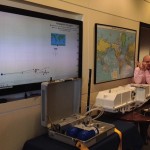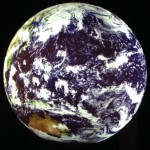Fast becoming my favourite of all holidays as we celebrate the vast, diverse planet we live on.
Two years ago my employer provided seeds & small clay pots – and we planted on Earth Day. This year PS sponsored a company outing to NOAA – the National Oceanic & Atmospheric Administration, located here in Boulder.
Aside from the crazy amount of security required to enter NOAA, whatta super interesting day.
NOAA monitors climate change – measuring greenhouse gases in the atmosphere & the acidification of our oceans.
Discussing ice core samples extracted from Greenland & Antarctica, I got lost in the science & unfortunately zoned out when we walked down the National Weather Service hallway. Plugged back in as our guide discussed CO2 collection & plotting atmospheric data.
Ended our day by the Earth Ball, a model plotting everything from global electricity usage & oceanic warm spots to Facebook user locales.
Inspired to become more Earth-friendly, have personally committed to reusable bags this year. Be good to Mother Earth folks, we share space on this beautiful, live-giving planet. If not for you, do it for future generations 🙂
- NOAA – Nat’l Oceanic & Atmospheric Administration
- monitoring weather on our Sun & neighboring planets
- collecting samples & plotting atmospheric CO2 data
- Mother Earth – the remarkable planet we share
Antarctica May Have Hit Highest Temperature on Record
By Brian Clark Howard, National Geographic
PUBLISHED MARCH 31, 2015
Scientists have measured what is likely the highest temperature ever on Antarctica: 63.5 degrees Fahrenheit.
The measurements were made last Tuesday at Argentina’s Esperanza Base, on the northern tip of the Antarctic Peninsula, according to the meteorological website Weather Underground. The previous hottest known temperature on the continent was 62.8°F (17.1°C), recorded at Esperanza Base on April 24, 1961.
The Weather Underground called last week’s temperatures a “remarkable heat wave,” although they occurred during the end of the austral summer, when Antarctic temperatures are typically highest.
The temperature has yet to be certified as an official record for the continent by the World Meteorological Organization.
It’s hard to draw much conclusion from a single temperature record, cautions Gavin Schmidt, a climate scientist with NASA’s Goddard Institute for Space Studies in New York City. Last year Antarctica also logged a record cold temperature, he notes.
What’s more important are the long-term trends, says Schmidt. And when it comes to Antarctica, he points out, the past few years “have actually been quite complex.”
The world’s ocean has been warming rapidly, absorbing much of the planet’s excess heat. As a result, large glaciers on or around Antarctica that come in contact with the warming water have been melting rapidly. But some other glaciers farther inland on the continent are actually growing.
“That has not been satisfactorily explained,” says Schmidt.
The science is particularly complex because the ozone hole continues to affect the region’s climate in ways that aren’t well understood. And global circulation of winds and currents remains a challenge for scientists to grasp.
“One record warm temperature doesn’t cut through all that complexity,” says Schmidt.
When it comes to the whole planet, the Earth remains on track to warm by an average of at least two degrees C (3.6 degrees F) by the end of the century, scientists report, although precisely how much is expected to depend on countries’ abilities to reduce emissions of heat-trapping greenhouse gases.









Leave a Reply